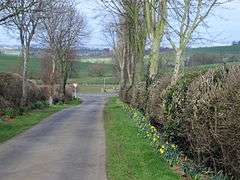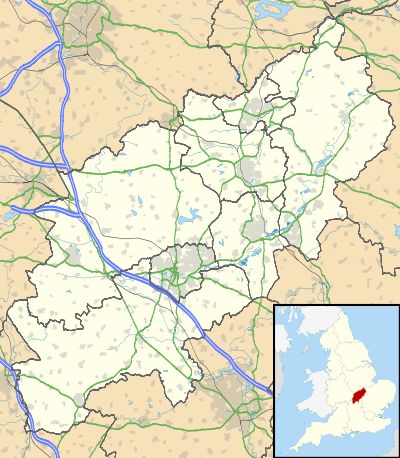Eastcote, Northamptonshire
Eastcote is a small village in the shire county of Northamptonshire (Northants), England. It is about 7 miles (11.3 km) south-west of the county town of Northampton along Banbury Lane. It is close to the A5 road, the Roman Road known as Watling Street, about 4 miles (6.4 km) north-west of Towcester. Prior to the opening in the 1959 of the M1 Motorway and the M6 Motorway a little later, the A5 was the main route by road from London to north Wales and north-west England.
| Eastcote | |
|---|---|
 Daffodils on Pound Lane, Eastcote. The "pound" was an enclosure for cattle to be penned in overnight while being driven on the hoof to Banbury market, often from as far away as Scotland | |
 Eastcote Location within Northamptonshire | |
| OS grid reference | SP680540 |
| Civil parish | |
| District | |
| Shire county | |
| Region | |
| Country | England |
| Sovereign state | United Kingdom |
| Post town | TOWCESTER |
| Postcode district | NN12 |
| Dialling code | 01327 |
| Police | Northamptonshire |
| Fire | Northamptonshire |
| Ambulance | East Midlands |
| UK Parliament | |
Governance
The village is grouped with several other small villages into the parish council of the nearby larger village of Pattishall. The District Council is South Northamptonshire District Council where the village is part of Blakesley and Cote ward. This is a two-member ward currently both Conservative.
History
Eastcote House stood in 60 acres and was owned by a Mr Gresham. The house was demolished around the middle of the 20th century.[1] Just before the start of World War I, the house was sold as a retirement home to the National Sailor's and Firemen's Union of England as a retirement home. The Union decided that they would help German seaman and prepared an internment camp initially housing 50 men, following the sinking of the Lusitania on the 7th May 1915, the internees were informed of the sinking and the loss of fellow merchant navy sailors, when the leader of the union left the concert room the internees started to sing German songs which upset the union leader/camp commandant was very upset and the following morning he a meeting was held in the war office and the camp was handed over to the Government and barbed wire was erected around the camp. Most of the internees were transferred out of the camp by July 1916. The camp became a POW camp expanding to about 4500 men by 1919 complete with a new water supply, sewage system, hospital, theatre and workshop. The village of Pattishall did not have electricity until the 1930's. After the war the property was sold by the union. There were periodic escapes: seven men escaped in 1917 but all were caught
References
- Northamptonshire Chronicle & Echo, "Dark Years of PoW Camp" , Published 2014_02_06